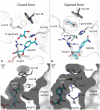New insights into the mechanism of substrates trafficking in Glyoxylate/Hydroxypyruvate reductases
- PMID: 26865263
- PMCID: PMC4749974
- DOI: 10.1038/srep20629
New insights into the mechanism of substrates trafficking in Glyoxylate/Hydroxypyruvate reductases
Erratum in
-
Erratum: New insights into the mechanism of substrates trafficking in Glyoxylate/Hydroxypyruvate reductases.Sci Rep. 2016 Apr 20;6:23879. doi: 10.1038/srep23879. Sci Rep. 2016. PMID: 27094544 Free PMC article. No abstract available.
Abstract
Glyoxylate accumulation within cells is highly toxic. In humans, it is associated with hyperoxaluria type 2 (PH2) leading to renal failure. The glyoxylate content within cells is regulated by the NADPH/NADH dependent glyoxylate/hydroxypyruvate reductases (GRHPR). These are highly conserved enzymes with a dual activity as they are able to reduce glyoxylate to glycolate and to convert hydroxypyruvate into D-glycerate. Despite the determination of high-resolution X-ray structures, the substrate recognition mode of this class of enzymes remains unclear. We determined the structure at 2.0 Å resolution of a thermostable GRHPR from Archaea as a ternary complex in the presence of D-glycerate and NADPH. This shows a binding mode conserved between human and archeal enzymes. We also determined the first structure of GRHPR in presence of glyoxylate at 1.40 Å resolution. This revealed the pivotal role of Leu53 and Trp138 in substrate trafficking. These residues act as gatekeepers at the entrance of a tunnel connecting the active site to protein surface. Taken together, these results allowed us to propose a general model for GRHPR mode of action.
Figures




Similar articles
-
Structural basis of substrate specificity in human glyoxylate reductase/hydroxypyruvate reductase.J Mol Biol. 2006 Jun 30;360(1):178-89. doi: 10.1016/j.jmb.2006.05.018. Epub 2006 May 22. J Mol Biol. 2006. PMID: 16756993
-
A preliminary account of the properties of recombinant human Glyoxylate reductase (GRHPR), LDHA and LDHB with glyoxylate, and their potential roles in its metabolism.Biochim Biophys Acta. 2005 Dec 1;1753(2):209-16. doi: 10.1016/j.bbapap.2005.08.004. Epub 2005 Aug 22. Biochim Biophys Acta. 2005. PMID: 16198644
-
Identification of catalytically important amino acid residues for enzymatic reduction of glyoxylate in plants.Biochim Biophys Acta. 2013 Dec;1834(12):2663-71. doi: 10.1016/j.bbapap.2013.09.013. Epub 2013 Sep 27. Biochim Biophys Acta. 2013. PMID: 24076009
-
Human glyoxylate metabolism revisited: New insights pointing to multi-organ involvement with implications for siRNA-based therapies in primary hyperoxaluria.J Inherit Metab Dis. 2025 Jan;48(1):e12817. doi: 10.1002/jimd.12817. Epub 2024 Nov 24. J Inherit Metab Dis. 2025. PMID: 39582099 Free PMC article. Review.
-
Molecular aetiology of primary hyperoxaluria and its implications for clinical management.Expert Rev Mol Med. 2004 Jan 9;6(1):1-16. doi: 10.1017/S1462399404007203. Expert Rev Mol Med. 2004. PMID: 14987413 Review.
Cited by
-
Identification and Characterization of Genes Encoding the Hydroxypyruvate Reductases in Chlamydomonas Reveal Their Distinct Roles in Photorespiration.Front Plant Sci. 2021 Jun 24;12:690296. doi: 10.3389/fpls.2021.690296. eCollection 2021. Front Plant Sci. 2021. PMID: 34249060 Free PMC article.
-
Functional analysis of Rossmann-like domains reveals convergent evolution of topology and reaction pathways.PLoS Comput Biol. 2019 Dec 23;15(12):e1007569. doi: 10.1371/journal.pcbi.1007569. eCollection 2019 Dec. PLoS Comput Biol. 2019. PMID: 31869345 Free PMC article.
-
A novel engineered strain of Methylorubrum extorquens for methylotrophic production of glycolic acid.Microb Cell Fact. 2024 Dec 23;23(1):344. doi: 10.1186/s12934-024-02583-y. Microb Cell Fact. 2024. PMID: 39716233 Free PMC article.
-
Identification of a novel GRHPR mutation in primary hyperoxaluria type 2 and establishment of patient-derived iPSC line.Hum Cell. 2025 Jan 6;38(2):40. doi: 10.1007/s13577-024-01169-5. Hum Cell. 2025. PMID: 39757298
-
Phospholipid biosynthesis regulation for improving pigment production by Monascus in response to ammonium chloride stress.Appl Environ Microbiol. 2024 Oct 23;90(10):e0114624. doi: 10.1128/aem.01146-24. Epub 2024 Sep 17. Appl Environ Microbiol. 2024. PMID: 39287399 Free PMC article.
References
-
- Yoshikawa S. et al.. Structure of archaeal glyoxylate reductase from Pyrococcus horikoshii OT3 complexed with nicotinamide adenine dinucleotide phosphate. Acta Crystallogr. D Biol. Crystallogr. 63, 357–365 (2007). - PubMed
-
- Rumsby G. & Cregeen D. P. Identification and expression of a cDNA for human hydroxypyruvate/glyoxylate reductase. Biochimica et Biophysica Acta 1446, 383–388 (1999). - PubMed
-
- Hullin R. P. Glyoxylate reductase, two forms from Pseudomonas. Meth. Enzymol. 41, 343–348 (1975). - PubMed
-
- Yoshida T. et al.. Cloning and expression of the gene for hydroxypyruvate reductase (D-glycerate dehydrogenase from an obligate methylotroph Hyphomicrobium methylovorum GM2. Eur. J. Biochem. 223, 727–732 (1994). - PubMed
MeSH terms
Substances
LinkOut - more resources
Full Text Sources
Other Literature Sources
Molecular Biology Databases

